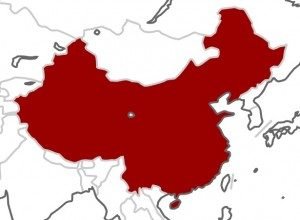By Ken Deji
Politics Correspondent
BEIJING (China Daily Show) — A senior Ministry of Interior Affairs official has claimed that the principal reason behind China’s annexation of Tibet and Xinjiang was to ensure future maps of Chinese territory form the exact shape of a giant chicken, documents released by WikiLeaks have revealed.
The highly emotional meeting, between minister Lu Penghuai and US diplomats, took place in June 2008, after riots in the Tibetan “tail feathers” region were dramatically quashed by state security forces.
If true, the documents could provide a tantalizing explanation as to why Beijing is so keen to retain regions whose non-Han populaces have plainly displayed great antipathy towards the Chinese government.
“The world’s greatest cultures all stemmed from countries shaped like recognizable objects,” Lu remarked to his anonymous American counterpart. “Italy, cradle of the Roman Empire and later founder-nation of both fascism and the shoe industry is shaped like a boot. Australia, leading light of the Southern hemisphere and dogged participant in both World Wars, looks like the noble head of a Scottish terrier.
“And, of course, the UK, birthplace of the world’s largest empire, is shaped like a giant witch with a pig under her arm. If we allowed the great China’s chicken’s wings and tail to be clipped, how could we hope to succeed as a nation?” Lu asked bemused diplomats.
“It was a firm belief of Chairman Mao’s [Zedong, the former Communist leader who invaded Tibet in 1950] that if China were shaped like a chicken it would give us the feng shui edge over the United States,” explained Professor Wang Ying of the National Cartography Bureau. “Mao used to joke that the US looks like nothing and that, if you ditch Alaska and Hawaii, its closest resemblance is to Cyprus, which he found pathetic.”

Tibet, conjoined with Yunnan and Sichuan provinces, form the chicken’s “thighs and buttocks,” said Professor Wang as he elaborated on the concept, while its wings spread over the Yangtze and Yellow river basins. The addition of Xinjiang allows the bird to “spread its wings.”
Mao’s “Reunite the Chicken’ campaign remained a secret Politburo strategy throughout the first few decades of Communist rule. Sympathy with China’s plight during World War Two, when, in Wang’s words, “our great bird’s head [Manchuria] was sliced off by the vicious katana of Japanese imperialists,” secured the return of the three large provinces in the north east from former allies the Soviet Union, before the relationship between the two soured after Stalin’s death.
Today, every schoolchild knows the country as the Dong Fang Xiong Ji or “Oriental Rooster” and Chairman Mao’s war diaries and political works are full of references to the chicken as the “most resourceful of all birds.”
In his popular 1948 essay, On Poultry and the Exploitation of the Masses, Mao remarks: “How like the Chinese peasant are the fowl he tends! We eat their meat and eggs, stuff mattresses with their feathers, make soup from their bones and use their droppings as fertilizer. What better symbol for the Chinese people, so useful when broken down into their component pieces?”
Historians had previously assumed that Tibet and Xinjiang – in which incidents of ethnic unrest have left 14 dead and 27 dead, respectively in July alone — were seized to create buffer zones against the then-Soviet Union in the North and India in the South, as well as ensure control over their precious natural resources.
But during a fraught exchange that took place at the Ministry of Interior Affairs, an annoyed Minister Lu is said to have lost patience with that view. “[Tibet and Xinjiang] are impractically remote, poor as dirt and [the native Tibetan and Uighur peoples] all hate us. They drain massive amounts of money to remain even barely functional. Who the hell would want them?” leaked cables report Lu as screaming.
“Unless, of course, incorporating them into our sovereign territory allowed our national border to form the shape of a barnyard animal,” he said, pausing to catch his breath before adding, “Which they do, and it’s great.”
This admission explains why former US President George W Bush’s alleged clucking and making of “chicken-wing” gestures during bilateral talks in the run-up to the 2003 invasion of Iraq failed to prevent China opposing UN sanctions against Saddam Hussein. “We thought it was a compliment,” remarked Lu.
Got a tip? Contact us at cds@chinadailyshow.net
Follow this and other leading China news at @chinadailyshow on Twitter
